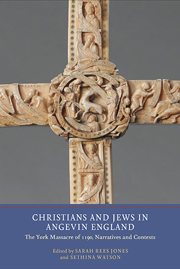Book contents
- Frontmatter
- Contents
- List of Illustrations
- Contributors
- Editor's Preface and Acknowledgments
- Abbreviations
- Introduction: The Moment and Memory of the York Massacre of 1190
- Part I The Events of March 1190
- Part II Jews among Christians in Medieval England
- Part III Representations
- 12 Egyptian Days: From Passion to Exodus in the Representation of Twelfth-Century Jewish-Christian Relations
- 13 ‘De Judaea, muta et surda’: Jewish Conversion in Gerald of Wales's Life of Saint Remigius
- 14 Dehumanizing the Jew at the Funeral of the Virgin Mary in the Thirteenth Century (c. 1170–c. 1350)
- 15 Massacre and Memory: Ethics and Method in Recent Scholarship on Jewish Martyrdom
- 16 The Future of the Jews of York
- Afterword: Violence, Memory and the Traumatic Middle Ages
- Bibliography
- Index
- York Medieval Press: Publications
15 - Massacre and Memory: Ethics and Method in Recent Scholarship on Jewish Martyrdom
from Part III - Representations
Published online by Cambridge University Press: 05 May 2013
- Frontmatter
- Contents
- List of Illustrations
- Contributors
- Editor's Preface and Acknowledgments
- Abbreviations
- Introduction: The Moment and Memory of the York Massacre of 1190
- Part I The Events of March 1190
- Part II Jews among Christians in Medieval England
- Part III Representations
- 12 Egyptian Days: From Passion to Exodus in the Representation of Twelfth-Century Jewish-Christian Relations
- 13 ‘De Judaea, muta et surda’: Jewish Conversion in Gerald of Wales's Life of Saint Remigius
- 14 Dehumanizing the Jew at the Funeral of the Virgin Mary in the Thirteenth Century (c. 1170–c. 1350)
- 15 Massacre and Memory: Ethics and Method in Recent Scholarship on Jewish Martyrdom
- 16 The Future of the Jews of York
- Afterword: Violence, Memory and the Traumatic Middle Ages
- Bibliography
- Index
- York Medieval Press: Publications
Summary
History, it seems, must always suffer the impositions of second guessing. If this is true of historical events, the traditional content of historical accounts, it is no less true of historiography, that higher order analysis which is itself a venerable form of retrospective re-examination. We continuously revise our understanding of historical explanations as well as events. In a volume dedicated to revisiting the massacre at York in 1190 and its legacy, I take it as given that part of our task is to consider what kinds of tools we have in our scholarly arsenal in the early twenty-first century for evaluating that moment and its context, in terms that encompass contemporary historiographical trends as well as medieval documents. My own small part in this project is to reflect on the intellectual moment in which we find ourselves, and to consider briefly how this context might offer some new resources as well as new challenges for engaging with the events at York.
A critical aspect of our current intellectual climate is what I will call an emergent paradigm shift in medieval Jewish studies that is at once methodological and ethical. Recently we have seen the development of competing historiographical views of the phenomenon of Jewish self-martyrdom in medieval Europe that I will try to summarize clearly, if rather schematically. On the one hand are those interpretations that fall within a tradition that might be described as memorializing, and tend to frame acts of medieval Jewish self-sacrifice primarily as heroic demonstrations of communal self-assertion. This perspective is prominently represented by Robert Chazan, though his work is part of a longstanding post-Holocaust historiographical tradition.
- Type
- Chapter
- Information
- Christians and Jews in Angevin EnglandThe York Massacre of 1190, Narratives and Contexts, pp. 261 - 277Publisher: Boydell & BrewerPrint publication year: 2013



